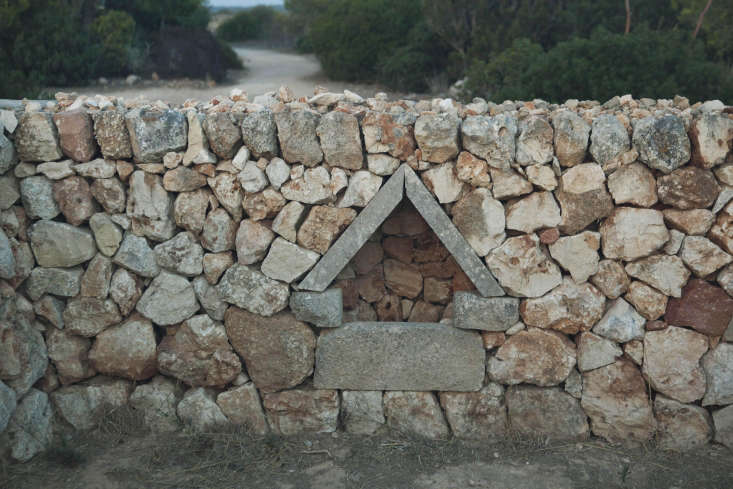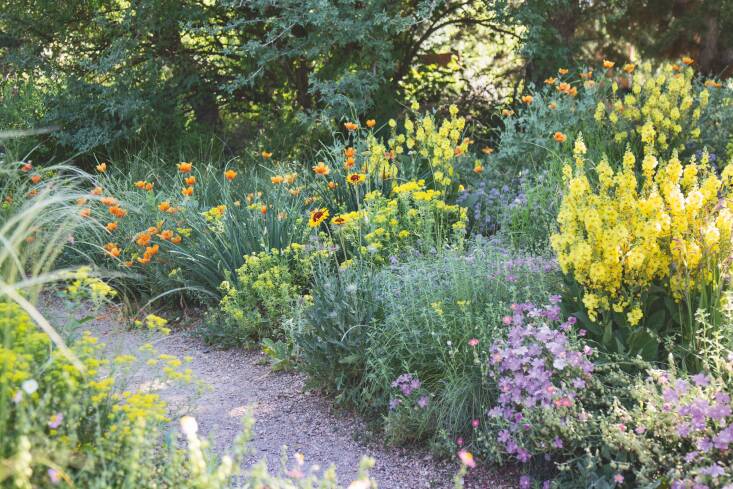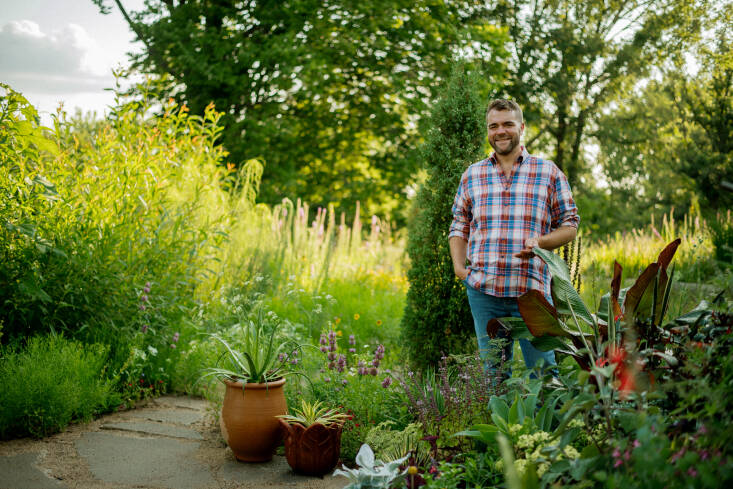Although stone walls have been around since the Stone Age, they have not been improved on in terms of beauty and utility. Sourced locally, or even on your property, stone is an intrinsically low-carbon material, giving a garden instant atmosphere, and a sense of belonging within the wider locale. They can even be made out of all the rubble and detritus left over from a remodel that would otherwise go to the landfill.
Dry stone walls involve the artistry of skilled craftspeople—or maybe your own (see Hardscaping 101: Dry Stone Walls for a how-to). And they are not just for us to admire; they provide an extra layer of good-looking habitat.
Let’s take a look at some different examples:
Above: A dry stone wall with a built-in livestock feeder in Menorca, Spain. Other add-ons can include steps and openings as escape routes for animals and stormwater. Photograph by Jim Powell.
In a stony area, where limestone, for instance, can be found under a thin layer of soil, stones of every shape and size can be pressed into service. Duncan Nuttall is a garden maker based in Bristol who teaches dry stone and dry rubble walling. With both, “a variety of niches are created, and these are perfect for many creatures, including lizards, spiders—and the nesting blue tits that we found in one of ours.” Installing a built-in gap at the bottom allows the free passage of hedgehogs (in the UK) and the free passage of small creatures that are stumped by our mania for security fences.
 Above: A dividing wall, rather than a perimeter wall, speaks to the local vernacular, with paths, pools and water bowls all made from the same stone. See: A Sense of Place: The Work of Garden Designer Caleb Davis in Maine.
Above: A dividing wall, rather than a perimeter wall, speaks to the local vernacular, with paths, pools and water bowls all made from the same stone. See: A Sense of Place: The Work of Garden Designer Caleb Davis in Maine.
 Above: The stony Cotswolds are traced with Cotswold stone walls. Photograph by Britt Willoughby.
Above: The stony Cotswolds are traced with Cotswold stone walls. Photograph by Britt Willoughby.
Stone walls attract small mammals that, in turn, attract larger mammal predators. Phil Brown, a stone waller in Gloucestershire who recently built 550 yard of dry stone walls for landscape architect Jinny Blom, observes: “Stoats and weasels hunt the bottom of the walls. You’ll always find mice skeletons when you take old walls down.”
 Above: A rubble wall at Hilldrop, the home of Care Not Capital, a new garden training enterprise from John Little of the Grass Roof Company. Photograph via Care Not Capital.
Above: A rubble wall at Hilldrop, the home of Care Not Capital, a new garden training enterprise from John Little of the Grass Roof Company. Photograph via Care Not Capital.
A garden redesign is a perfect opportunity for reusing the material that goes into walls. A rubble wall, made of leftover building materials and awkward pieces that might include cement themselves (as shown above), repurposes waste and is most effective when put together by someone with a good eye. Nuttall is a fine art graduate and easily able to rise to the challenge of making something out of nothing. He teaches this technique at Care Not Capital, a new garden training program founded by John Little (see The Romance of Rubble: Why People Are Talking About Gardening With Impoverished Soil). Its manifesto is a call to move investment away from expensive and wasteful infrastructure toward the care that is needed to properly look after a space. “By providing training in almost everything but horticulture, we’re equipping the ‘modern gardener’ to create sustainable green spaces for a changing world.”
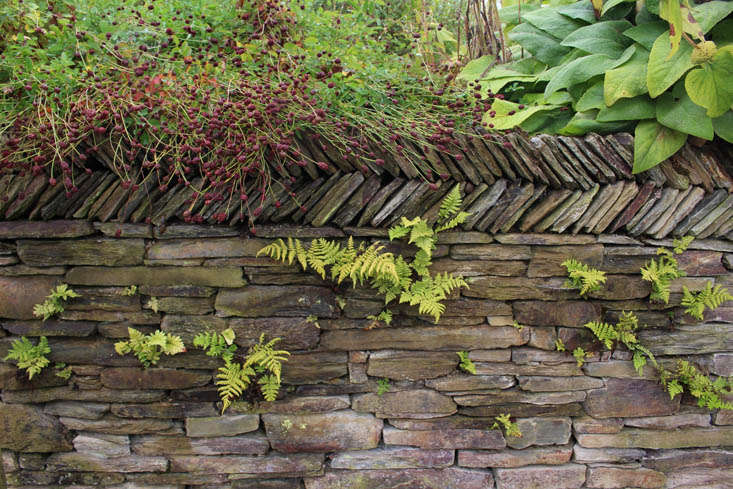 Above: Traditional walls in Cornwall, England, are built or finished off in “cursy-wavy” fashion, as demonstrated here at the Duchy of Cornwall Nursery near Lostwithiel. The rainforest conditions of the western British Isles allow every un-cemented wall to support a diversity of plants and therefore wildlife. Photograph by Kendra Wilson.
Above: Traditional walls in Cornwall, England, are built or finished off in “cursy-wavy” fashion, as demonstrated here at the Duchy of Cornwall Nursery near Lostwithiel. The rainforest conditions of the western British Isles allow every un-cemented wall to support a diversity of plants and therefore wildlife. Photograph by Kendra Wilson.
The narrow lanes of Cornwall are hemmed in by towering Cornish hedges, which are essentially dry stone walls with so much greenery taking root in them that you no longer see the slate they are made from. Says Duncan: “They’re filled with soil in the middle, with a hedge planted on top, and that stops livestock from jumping up on top of the wall.” They are field boundaries that make use of the materials at hand and are “three-dimensional pieces of meadow.”
The way the soil moves through a wall without mortar creates pockets for plants to take root but also makes more spaces for habitat than a regular dry stone wall. “Solitary bees can create nests in this in the earth core, and you start to encourage plants to germinate and add another layer of ecology to the wall, providing food for insects.” The idea must be exportable.
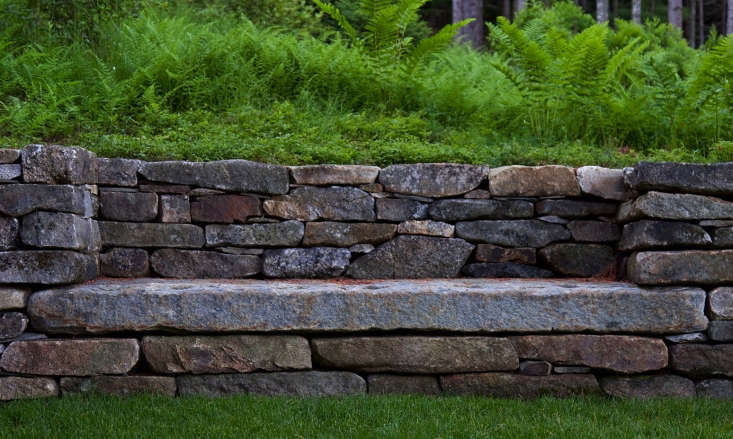 Above: A dry-laid granite retaining wall with a built-in bench. Photograph courtesy of Matthew Cunningham Landscape Design, from After the Hurricane: The Resurrection of a Wild Garden in Maine.
Above: A dry-laid granite retaining wall with a built-in bench. Photograph courtesy of Matthew Cunningham Landscape Design, from After the Hurricane: The Resurrection of a Wild Garden in Maine.
See also:

